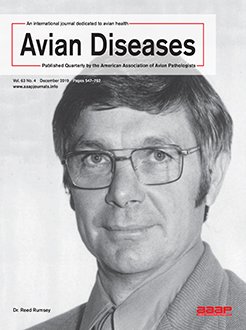Angélique Travel, Jean-Paul Metayer, Amandine Mika, Jean-Denis Bailly, Didier Cleva, Cyril Boissieu, Jean Le Guennec, Olivier Albaric, Sophie Labrut, Gurvan Lepivert, Eric Marengue, Pascal Froment, Didier Tardieu, Philippe Guerre
Avian Diseases 63 (4), 703-712, (5 September 2019) https://doi.org/10.1637/aviandiseases-D-19-00073
KEYWORDS: mycotoxins, feed, fumonisins, deoxynivalenol, zearalenone, multiple contamination, toxicity, turkeys
Surveys of mycotoxins worldwide have shown that deoxynivalenol (DON), fumonisins (FB), and zearalenone (ZON) are the most abundant Fusarium mycotoxins (FUS) in European poultry feed, in both the level and the frequency of contamination. Previous studies reported that a combination of FUS at concentrations that individually are not toxic may negatively affect animals. However, although toxic thresholds and regulatory guidelines exist for FUS, none account for the risk of multiple contamination, which is the most frequent. The aim of this study was to compare DON, FB, and ZON toxicity, alone and in combination, in male turkey poults. Ground cultured toxigenic Fusarium strains were incorporated in corn–soybean-based feed in five experimental diets: control diet, containing no mycotoxins, DON diet (5 mg DON/kg), FB diet (20 mg FB1 + FB2/ kg), ZON diet (0.5 mg ZON/kg), and DONFBZON diet (5, 20, and 0.5 mg/kg of DON, FB1 + FB2, and ZON, respectively). Seventy male Grade Maker turkeys were reared in individual cages on mycotoxin-free diets from 0 to 55 days of age. On the 55th day, the turkeys were weighed and divided into five groups each comprising 14 birds. Each group was fed one of the five experimental diets for a period of 14 days. On the 70th day of age, feed was withheld for 8 hr, at which time a blood sample was collected, and then all the turkeys were killed, autopsied, and different tissues sampled. The weight of the different organs, analyses of performance, biochemistry, histopathology, oxidative damage, and testis toxicity revealed no significant effects attributable to FUS. Measurement of sphingolipids in the liver revealed an increase in the sphinganine to sphingosine ratio in turkeys fed diets containing FB, but had no apparent consequences in terms of toxicity. Finally, only slight differences were found in some variables and the results of this study showed no interactions between DON, FB, and ZON. Taken together, results thus suggest that the maximum tolerated levels established for individual contamination by DON, FB, and ZON can also be considered safe in turkeys fed with combinations of these FUS for a period of 14 days.

